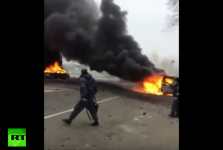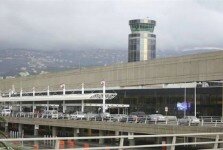Authorities not clear if 98 people unaccounted for from fire-hit Adriatic ferry died in the fire, died at sea or never boarded the vessel in the first place
Up to 100 people are still feared missing from a ferry that caught fire in the Adriatic as stormy weather prevented Italian authorities from towing the ship to the port of Brindisi for a thorough search.
The uncertainty over the number of victims was caused by confusion as to whether some passengers were not recorded on official lists, and suspicions that illegal immigrants were on board the Norman Atlantic.
At least 11 people died after fire tore through the car ferry on Sunday as it travelled from Greece to Italy.
During an intense, 34-hour operation, hundreds of passengers and crew, including Britons, were rescued, but 98 are still thought to be missing.
It is not known whether they died in the fire, which left the ferry a blackened, smouldering wreck, whether they died at sea or whether they never boarded the vessel in the first place.
Three illegal immigrants have so far been identified – two Afghans and a Syrian – all of whom requested political asylum once they reached Italy.
It is suspected that others may have been hiding inside lorries on board the ferry. Other passengers may have suffocated to death from smoke or been burned to death as they slept in their cabins.
“We will only be able to ascertain the definitive number [of dead] when the ship is inspected,” said Giuseppe Volpe, a prosecutor in Bari, who is leading the investigation into the accident.
The ferry was lying around 10 nautical miles off the coast of Albania, near the coastal city of Vlore, Albania’s second largest port. Italian tug boats are on standby to tow it to Brindisi once the weather improves.
“The ship is now under Italian jurisdiction and will be taken to Italy,” Hysni Aruci, an Albanian coast guard official, told Ansa news agency.
The Italian authorities believe there were up to 499 people on board the ferry, of which 390 have been rescued and 11 are dead. Post-mortems were conducted on Wednesday on nine bodies, including those of two Italian truck drivers who died in the disaster.
Argilio Giacomazzi, the captain of the ferry, was questioned for five hours by investigators in the port of Bari.
The captain’s decision to be the last off the ship has been favourably contrasted with the conduct of Francesco Schettino, the former captain of the Costa Concordia, who is on trial for allegedly abandoning the cruise ship while hundreds of passengers and crew were still on board after it capsized off the island of Giglio in Jan 2012.
Capt Giacomazzi insisted that “all safety procedures were respected” – a claim which sharply diverges from the testimony of survivors, who said that passengers fought to be rescued and that the crew were nowhere to be seen as the blaze spread out of control.
They said they received no instructions from crew members, that no alarm was given and that the deck of the ship became so hot that their shoes started melting.
Ute Kilger, a passenger from Munich, described how she saw a middle-aged man shove past women, children and the elderly to ensure he was winched to safety by a helicopter before them.
“He just went and sat in the basket, which was clearly designed for children. I didn’t know whether to laugh or cry,” the 45-year-old lawyer told Italian media.
The captain, as well as the vessel’s Italian owners, could be charged with manslaughter.
Greek and Turkish survivors of the disaster were flown back to their home countries on Wednesday, although the repatriation flights were hampered by bad weather and the fact that many people had lost their passports.






